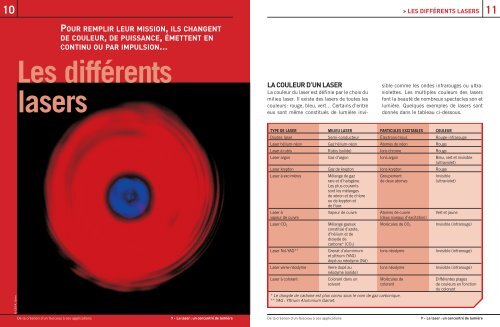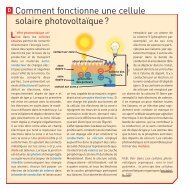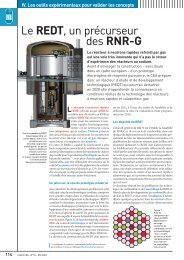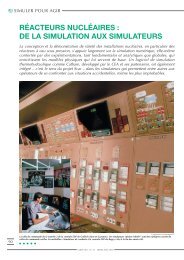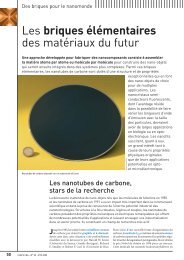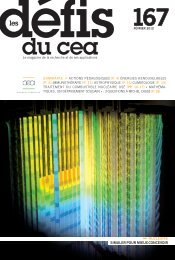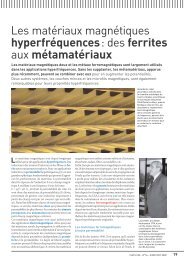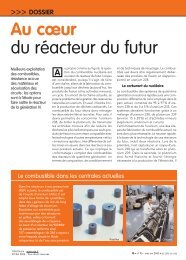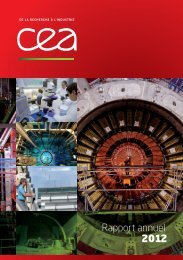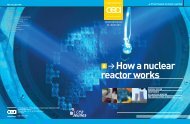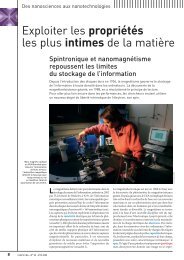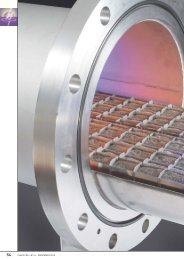Le laser: un concentré de lumière 9 >Le laser: un concentré ... - CEA
Le laser: un concentré de lumière 9 >Le laser: un concentré ... - CEA
Le laser: un concentré de lumière 9 >Le laser: un concentré ... - CEA
You also want an ePaper? Increase the reach of your titles
YUMPU automatically turns print PDFs into web optimized ePapers that Google loves.
10<br />
> LES DIFFÉRENTS LASERS<br />
11<br />
POUR REMPLIR LEUR MISSION, ILS CHANGENT<br />
DE COULEUR, DE PUISSANCE, ÉMETTENT EN<br />
CONTINU OU PAR IMPULSION…<br />
<strong>Le</strong>s différents<br />
<strong>laser</strong>s<br />
LA COULEUR D’UN LASER<br />
La couleur du <strong>laser</strong> est définie par le choix du<br />
milieu <strong>laser</strong>. Il existe <strong>de</strong>s <strong>laser</strong>s <strong>de</strong> toutes les<br />
couleurs : rouge, bleu, vert… Certains d’entre<br />
eux sont même constitués <strong>de</strong> <strong>lumière</strong> invisible<br />
comme les on<strong>de</strong>s infrarouges ou ultraviolettes.<br />
<strong>Le</strong>s multiples couleurs <strong>de</strong>s <strong>laser</strong>s<br />
font la beauté <strong>de</strong> nombreux spectacles son et<br />
<strong>lumière</strong>. Quelques exemples <strong>de</strong> <strong>laser</strong>s sont<br />
donnés dans le tableau ci-<strong>de</strong>ssous.<br />
© <strong>CEA</strong>/A. Gonin<br />
De la création d’<strong>un</strong> faisceau à ses applications<br />
9 > <strong>Le</strong> <strong>laser</strong> : <strong>un</strong> <strong>concentré</strong> <strong>de</strong> <strong>lumière</strong><br />
TYPE DE LASER MILIEU LASER PARTICULES EXCITABLES COULEUR<br />
Dio<strong>de</strong>s <strong>laser</strong> Semi-conducteur Électrons-trous Rouge-infrarouge<br />
Laser hélium-néon Gaz hélium-néon Atomes <strong>de</strong> néon Rouge<br />
Laser à rubis Rubis (soli<strong>de</strong>) Ions chrome Rouge<br />
Laser argon Gaz d’argon Ions argon Bleu, vert et invisible<br />
(ultraviolet)<br />
Laser krypton Gaz <strong>de</strong> krypton Ions krypton Rouge<br />
Laser à excimères Mélange <strong>de</strong> gaz Groupement Invisible<br />
rare et d’halogène. <strong>de</strong> <strong>de</strong>ux atomes (ultraviolet)<br />
<strong>Le</strong>s plus courants<br />
sont les mélanges<br />
<strong>de</strong> xénon et <strong>de</strong> chlore<br />
ou <strong>de</strong> krypton et<br />
<strong>de</strong> fluor.<br />
Laser à Vapeur <strong>de</strong> cuivre Atomes <strong>de</strong> cuivre Vert et ja<strong>un</strong>e<br />
vapeur <strong>de</strong> cuivre<br />
(<strong>de</strong>ux niveaux d’excitation)<br />
Laser CO 2 Mélange gazeux Molécules <strong>de</strong> CO 2 Invisible (infrarouge)<br />
constitué d’azote,<br />
d’hélium et <strong>de</strong><br />
dioxy<strong>de</strong> <strong>de</strong><br />
carbone* (CO 2 )<br />
Laser Nd-YAG** Grenat d’aluminium Ions néodyme Invisible (infrarouge)<br />
et yttrium (YAG)<br />
dopé au néodyme (Nd)<br />
Laser verre-néodyme Verre dopé au Ions néodyme Invisible (infrarouge)<br />
néodyme (soli<strong>de</strong>)<br />
Laser à colorant Colorant dans <strong>un</strong> Molécules <strong>de</strong> Différentes plages<br />
solvant colorant <strong>de</strong> couleurs en fonction<br />
du colorant<br />
* <strong>Le</strong> dioxy<strong>de</strong> <strong>de</strong> carbone est plus connu sous le nom <strong>de</strong> gaz carbonique.<br />
** YAG: Yttrium Aluminium Garnet.<br />
De la création d’<strong>un</strong> faisceau à ses applications<br />
9 > <strong>Le</strong> <strong>laser</strong> : <strong>un</strong> <strong>concentré</strong> <strong>de</strong> <strong>lumière</strong>


